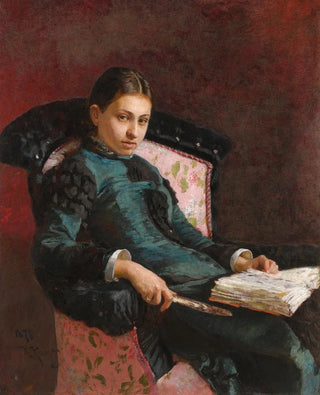Art print | Portrait of the artist's wife, Vera Repin - Ilya Efimovich Repin


View from behind

Frame (optional)
In the vibrant universe of 19th-century Russian art, the artwork "Art print of the artist's wife, Vera Repin" stands out for its emotional depth and refined technique. This portrait, created by Ilya Efimovich Repin, goes beyond a simple physical representation; it evokes an intimacy and a profound understanding between the artist and his model. Vera, Repin's wife, embodies both the muse and the reflection of her husband's artistic aspirations. Through this painting, we are invited to delve into the intimacy of a couple where love and art blend harmoniously, offering a poignant glimpse into their shared life.
Style and uniqueness of the work
Repin's style is characterized by striking realism, where every detail is meticulously observed. In this portrait, light plays a crucial role, illuminating Vera's face in a way that highlights her delicate features and gentle expression. The colors chosen, subtly nuanced, create a warm and welcoming atmosphere. Repin does not merely reproduce his wife's appearance; he manages to capture her essence, her character, and even her thoughts. The subtle expressions that emerge on her face testify to a rare sensitivity, making the viewer a witness to a moment suspended in time. This painting, with its harmonious composition and skillful use of light, stands out not only for its beauty but also for the psychological depth it conveys.
The artist and his influence
Ilya Efimovich Repin is one of the emblematic figures of Russian art. His artistic journey is marked by a constant desire to explore the human condition through his works. Repin, who drew inspiration from great European masters while developing his own style, influenced many artists of his time and subsequent generations. His realistic approach and attention to detail have allowed his works to transcend time, making him a pillar of art history. In the "Art print of the artist's wife," the artist does not merely depict his wife; he immortalizes a relationship, an era,

Matte finish

View from behind

Frame (optional)
In the vibrant universe of 19th-century Russian art, the artwork "Art print of the artist's wife, Vera Repin" stands out for its emotional depth and refined technique. This portrait, created by Ilya Efimovich Repin, goes beyond a simple physical representation; it evokes an intimacy and a profound understanding between the artist and his model. Vera, Repin's wife, embodies both the muse and the reflection of her husband's artistic aspirations. Through this painting, we are invited to delve into the intimacy of a couple where love and art blend harmoniously, offering a poignant glimpse into their shared life.
Style and uniqueness of the work
Repin's style is characterized by striking realism, where every detail is meticulously observed. In this portrait, light plays a crucial role, illuminating Vera's face in a way that highlights her delicate features and gentle expression. The colors chosen, subtly nuanced, create a warm and welcoming atmosphere. Repin does not merely reproduce his wife's appearance; he manages to capture her essence, her character, and even her thoughts. The subtle expressions that emerge on her face testify to a rare sensitivity, making the viewer a witness to a moment suspended in time. This painting, with its harmonious composition and skillful use of light, stands out not only for its beauty but also for the psychological depth it conveys.
The artist and his influence
Ilya Efimovich Repin is one of the emblematic figures of Russian art. His artistic journey is marked by a constant desire to explore the human condition through his works. Repin, who drew inspiration from great European masters while developing his own style, influenced many artists of his time and subsequent generations. His realistic approach and attention to detail have allowed his works to transcend time, making him a pillar of art history. In the "Art print of the artist's wife," the artist does not merely depict his wife; he immortalizes a relationship, an era,






